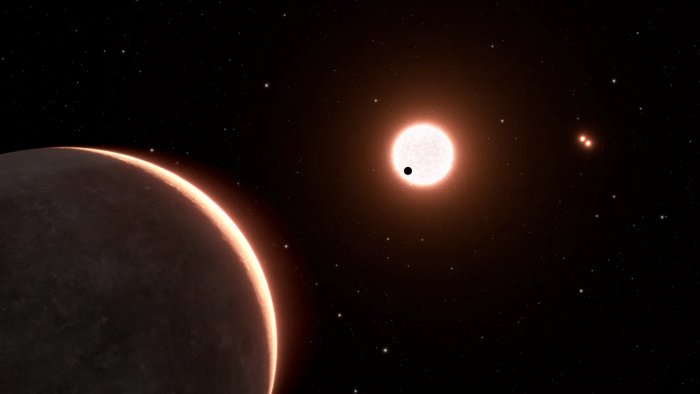Size Of The Nearest Transiting Earth-Sized Planet – Measured By NASA’s Hubble
Eddie Gonzales Jr. – MessageToEagle.com – NASA’s Hubble Space Telescope has measured the size of the nearest Earth-sized exoplanet that passes across the face of a neighboring star. This alignment, called a transit, opens the door to follow-on studies to see what kind of atmosphere, if any, the rocky world might have.
This is an artist’s concept of the nearby exoplanet LTT 1445Ac, which is the size of Earth. The planet orbits a red dwarf star. The star is in a triple system, with two closely orbiting red dwarfs seen at upper right. The black dot in front of the bright light-red sphere at image center is planet LTT 1445Ac transiting the face of the star. The planet has a surface temperature of roughly 500 degrees Fahrenheit. In the foreground at lower left is another planet in the system, LTT 1445Ab. The view is from 22 light-years away, looking back toward our Sun, which is the bright dot at lower right. Some of the background stars are part of the constellation Boötes. Credit: NASA, ESA, Leah Hustak (STScI)
The diminutive planet, LTT 1445Ac, was first discovered by NASA’s Transiting Exoplanet Survey Satellite (TESS) in 2022. But the geometry of the planet’s orbital plane relative to its star as seen from Earth was uncertain because TESS does not have the required optical resolution. This means the detection could have been a so-called grazing transit, where a planet only skims across a small portion of the parent star’s disk. This would yield an inaccurate lower limit of the planet’s diameter.
“There was a chance that this system has an unlucky geometry and if that’s the case, we wouldn’t measure the right size. But with Hubble’s capabilities we nailed its diameter,” said Emily Pass of the Center for Astrophysics | Harvard & Smithsonian in Cambridge, Massachusetts.
Hubble observations show that the planet makes a normal transit fully across the star’s disk, yielding a true size of only 1.07 times Earth’s diameter. This means the planet is a rocky world, like Earth, with approximately the same surface gravity. But at a surface temperature of roughly 500 degrees Fahrenheit, it is too hot for life as we know it.
The planet orbits the star LTT 1445A, which is part of a triple system of three red dwarf stars that is 22 light-years away in the constellation Eridanus. The star has two other reported planets that are larger than LTT 1445Ac. A tight pair of two other dwarf stars, LTT 1445B and C, lies about 3 billion miles away from LTT 1445A, also resolved by Hubble. The alignment of the three stars and the edge-on orbit of the BC pair suggests that everything in the system is co-planar, including the known planets.
“Transiting planets are exciting since we can characterize their atmospheres with spectroscopy, not only with Hubble but also with the James Webb Space Telescope. Our measurement is important because it tells us that this is likely a very nearby terrestrial planet. We are looking forward to follow-on observations that will allow us to better understand the diversity of planets around other stars,” said Pass.
This research has been accepted for publication in The Astronomical Journal.
Written by Eddie Gonzales Jr. – MessageToEagle.com Staff











